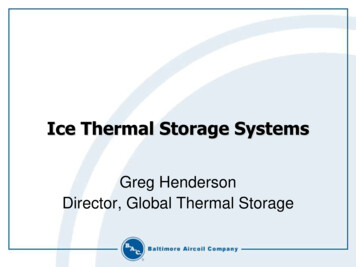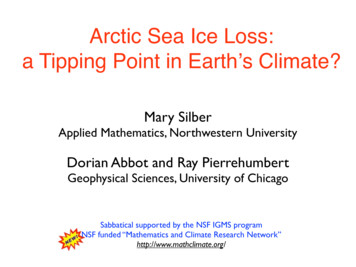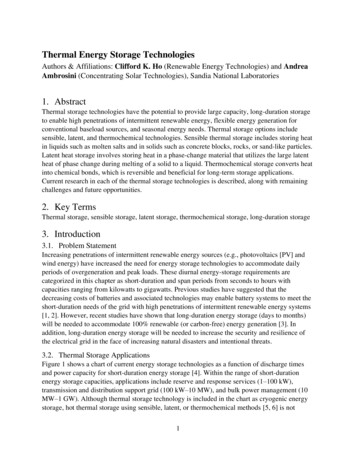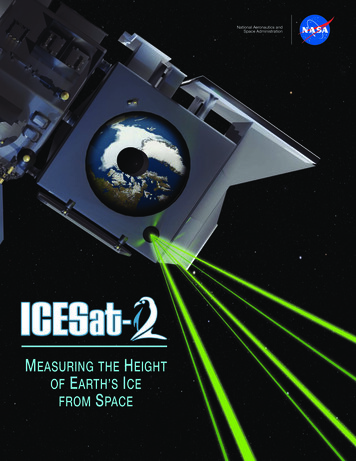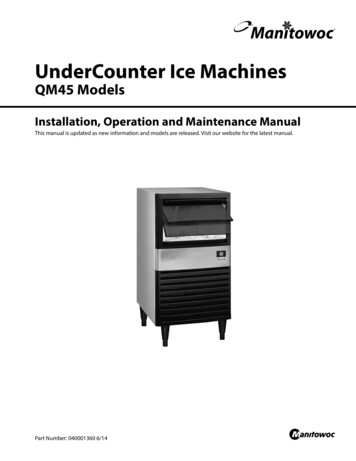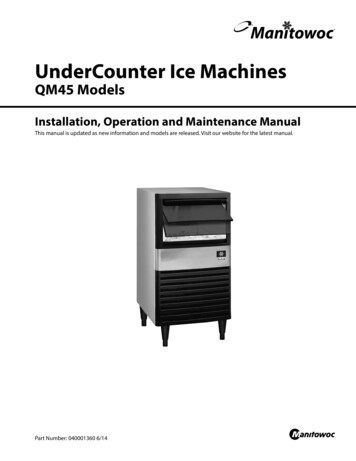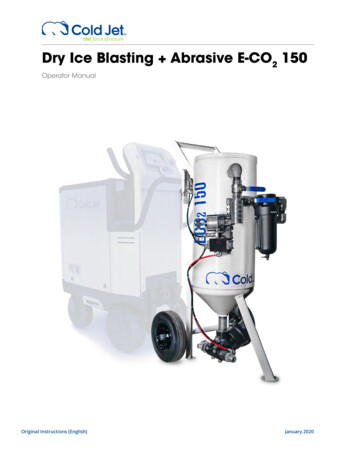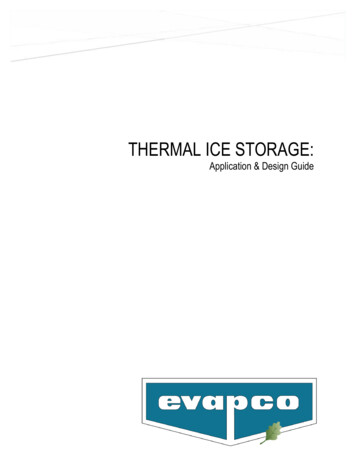
Transcription
THERMAL ICE STORAGE:Application & Design Guide
EVAPCO Ice Storage Application and Design GuideTable of Contents:1. Introduction A. History of Thermal Energy StorageB. Operating and Cost Benefits2. Applications A Fundamental SystemB. HVAC CoolingC. Process CoolingD. Turbine – Inlet Air CoolingE. District CoolingF. Developing Energy Sources – Solar and Wind3. Method of Ice Melt A. ExternalB. Internal4. Operating Strategies .A. Electric Cost & Rate SchedulesB. Selection - Types of Ice Melt SystemC. Full or Partial StorageD. System Modes of OperationE. Conventional Chiller Operation5. System Sizing – Design Day PerformanceA. Example – External Melt Spreadsheet (English Units)B. Example – Internal Melt Spreadsheet (Metric Units)6. Schematic Flow Diagrams and System Control Strategy A. External Melt:Figure 6A-1 Basic external melt system piping / control strategyFigure 6A-2 Basic system with added HX on ice water loop / control strategyFigure 6A-3 Basic system with a conventional chiller piped in series with the ice waterHX /control strategyFigure 6A-4 Basic system with HX (on both ice water and glycol loops) piped inseries / control strategyFigure 6A-5 Basic system with two conventional chillers piped in parallel with ice waterHX / control strategyFigure 6A-6 Basic system utilizing a dual evaporator chiller (ice build and watercooling) / control strategyB. Internal Melt:Figure 6B-1 Basic internal melt system piping / control strategy1
EVAPCO Ice Storage Application and Design GuideFigure 6B-2 Basic system with HX separating the glycol and ice water loops /control strategyFigure 6B-3 Basic System with two conventional chillers piped in parallel with icestorage & HX / control strategyC. District Cooling:Figure 6C-1 Distribution cooling primary and secondary Loops7. Storage Containers: .A. Design Considerations (Materials of Construction, Location and Access)B. WaterproofingC. InsulationD. Coil spacing and Physical Size8. Storage Tank Ice Coil Layout A. External MeltB. Internal Melt9. Example: Equipment Selection, Flow Schematic, andOn-Peak Demand Comparison: .A. External Melt - 7,000 Tons (English Units)B. External Melt - 24,640 kW (Metric Units)C. Internal Melt - 10,500 kW (Metric Units)D. Internal Melt - 3,000 Tons (English Units)10. Ice Storage System Control Accessories .A. Air agitation pumps (external & internal melt system)B. Ice thickness sensor (external melt systems)C. Automatic glycol zone valvesD Ice inventory sensor (external melt system)E. Ice inventory sensor (internal melt systems)11. Water Quality and Types of Glycol A. Water QualityB. Types of Glycol12. Maintenance .13. Commissioning .2
EVAPCO Ice Storage Application and Design Guide1. Introduction:A. History of Thermal Energy StorageThermal Energy Storage (TES) is the term used to refer to energy storage that is based on a change intemperature. TES can be hot water or cold water storage where conventional energies, such as naturalgas, oil, electricity, etc. are used (when the demand for these energies is low) to either heat or cool thestorage water. The energy is basically transferred, from conventional energy sources, to a temperaturedifferential in the storage water that can be utilized during high energy demand periods. The typicaldomestic hot water heater is an example of thermal hot water storage that is popular throughout the world.Thermal hot water storage and thermal chilled water storage applications are very common, and are usedfor both process and comfort heating and cooling systems.In the 1930’s, dairy farmers began using thermal ice storage to cool the daily batches of fresh milk.Normally, the milk cooling required large chillers that cooled for only a few peak hours (twice a day).Thermal ice storage offered the advantage of using much smaller refrigeration equipment that could buildand store ice over a 10 to 12-hour period. Each batch of fresh milk could be cooled quickly using ice melt,and the thermal ice storage system could be recharged in time for the next milking. Thermal Ice storage stillprovides a considerable amount of milk cooling in the dairy industry.Ice has played a major role in comfort cooling applications as well. Even the definition of a ton of cooling isderived using ice. The latent heat of fusion (phase change of water to ice or ice to water) is 144 Btu’s perpound of water. One ton of ice is 2,000 pounds, Therefore, the energy required to change 2,000 pounds ofwater to ice would be 144Btu/lb. x 2000 lb. 288,000 Btu’s. To accomplish this in a 24-hour period, thehourly energy rate would be 12,000 Btu’s per hour. This energy rate is defined as a ton of air conditioning.In the late 1970’s, a few creative engineers began to use thermal ice storage for air conditioningapplications. During the 1980’s, progressive electric utility companies looked at thermal energy storage asa means to balance their generating load and delay the need for additional peaking power plants. Theseutility companies offered their customers financial incentives to reduce their energy usage during selectedon-peak hours. On-peak electric energy (kWh) and electric demand (kW) costs increased substantially, yetnon-peak energy costs remain low.B. Operating and Cost BenefitsThermal energy storage was the perfect answer to the electric industries’ needs. Creative and innovativeowners and engineers applied the thermal ice storage concept to cooling applications ranging in size fromsmall elementary schools to large office buildings, hospitals, arenas and district cooling plants for collegecampuses and downtown metropolitan developments. As the technology evolved, it became obvious todesigners that thermal ice storage offered many additional installation, operation and cost benefits.Thermal ice storage is a proven technology that reduces chiller size and shifts compressor energy,condenser fan and pump energies, from peak periods, when energy costs are high, to non-peak periods,where electric energy is more plentiful and less expensive. The chiller operates during non-peak hours3
EVAPCO Ice Storage Application and Design Guidecooling a glycol solution to sub-freezing temperatures which is then circulated through the ice storage coils.Ice forms around the external surfaces of the coils, and a full storage charge is reached when the ice istypically 1.1 to 1.5 inches thick. The ice is ultimately melted and used as a cooling agent. There are twodifferent methods of ice melt and these will be explained in Section 3 – Methods of Ice melt.The most significant benefit of ice thermal storage is the reduction of on-peak electric demand and the shiftof energy use to non-peak hours. However, there are additional benefits that may not be as obvious tothose designing an ice thermal storage system for the first time. Depending on the method of ice melt, thecooling fluid temperature can be substantially reduced when compared to a conventional chilled watersystem. Leaving temperatures are often as low as 34 F to 36 C (1.1 C to 2.2 C). This colder fluid offersmany design benefits that reduce the overall system’s first cost and improve HVAC and process coolingperformance.The benefits of the colder fluid are often overlooked when evaluating thermal ice storage systems. Thesebenefits include:First cost savings: Reduced water and air distribution systems — Colder air and water fluids allow the designer touse larger delta-Ts. Rather than the conventional 10 F to 12 F (5.53 C to 6.63 C) delta-T, icestorage systems typically implement 18 F to 20 F (10.0 C to 11.1 C) delta-T distribution loops.These larger delta-Ts enable designers to reduce the volume of air and water required toadequately cool the space hence, smaller pipes and duct work can be used. Reduced horsepower (kW) requirements for pumps and fans — Designs using colder fluids andlarger delta-Ts reduce air and water flow requirements. Therefore, component sizes, includingthe electric motor size, can be smaller. Equipment and labor first cost savings can besubstantial. Reduced electrical distribution – Smaller components such as chillers, fans andpump motors reduce the connected system horsepower (kW) saving electrical distribution costsfrom the building main transformer to the starter panels. Reduced connected horsepower (kW)can also reduce the size of any emergency generation equipment that may be required. Building space savings – Smaller supply and return ducts require less floor area. Smaller airdistribution ducts reduce ceiling plenum height which provides a shorter floor to floor dimension.The result is less construction costs and more usable/rentable floor space.Long term benefits: The chillers will always operate at or near 100% capacity when charging the storage system andtypically at a higher capacity factor when compared with a conventional chilled water system.This reduces the amount of time chillers will operate at low load conditions, as well as on / offcycling based on cooling loads. When chillers are operated at or near full capacity most of thetime, they require less maintenance. Any fluctuation in the cooling load will be satisfied by theice storage. Process operations often have high cooling spikes of short duration. Chillers are not designed toload and unload quickly. Thermal ice storage can respond quickly and efficiently to loadvariations and can track rapid cooling spikes. Utility Electric Peak rate periods vary considerably. Demand periods may be 8 -10 hours or aseries of shorter 2-3 hour segments. Thermal ice storage is very effective with any utility time-ofday demand schedule and can be easily modified should rate periods change in the future.4
EVAPCO Ice Storage Application and Design GuideToday, there are thousands of thermal ice storage systems installed and operating worldwide and many ofthese have taken advantage of the benefits offered from lower temperatures.This Application Guide will focus on thermal ice storage. Specifically, the most popular “ice-on-coil” type asmanufactured by EVAPCO. The thermal ice storage system will be explained in detail starting with thedifferent applications and continuing through to system commissioning.2 Applications:A. Fundamental System.Any chilled water cooling system may be a good application for thermal ice storage. The systemoperation and components are similar to a conventional chilled water system. The main difference isthat thermal ice storage systems are designed with the ability to manage energy use based on thetime-of-day rather than the cooling requirements. The chiller is selected to cool a glycol solution to atemperature of 20 F-22 F (-6.7 C—5.6 C). The cold glycol is pumped through the ice storage coilswhich are located in the storage tank containing water. A ring of ice is formed around each coil tube.The ice build process occurs during the electric utility’s off-peak time period, when energy and demandcosts are very low. During the high price on-peak time period, the chiller, glycol and condenser waterpumps and cooling tower fans are turned off. A chilled water pump circulates the cooling water throughthe ice storage tank where it is cooled to the desired temperature and distributed throughout thesystem.This describes the fundamental thermal ice storage system. There is no limit to the size of the coolingsystem. However, for small systems (less than 100 tons (352 kW), thermal ice storage may beeconomically hard to justify. Large cooling systems with cooling capacities of several hundred orseveral thousand tons (kW) become easy to justify. In subsequent sections of this Application Guide,the fundamental system described above will be enhanced with: Choice of ice melt options Multiple operating modes Conventional chillers as well as ice build chillers Primary / secondary pumping loops Heat exchangers used to separate the different fluid loops (glycol. Ice melt, chilled water)B. HVAC Cooling:Comfort air conditioning systems are ideal candidates for thermal ice storage. Large horsepowercooling compressors operate during peak summer energy periods. Thermal ice storage can transfer allor part of this energy to non-peak hours. Cooling may be required year round in some locations, whileonly seasonally in others. Typical applications are: office buildings, hospitals, large retail stores,schools (elementary – university), sports arenas and stadiums.B. Process Cooling:This is a broad category with various applications including: Batch cooling where added heat must be removed (such as food processing) Batch cooling where internal heat is created that must be removed (such as chemical reactions5
EVAPCO Ice Storage Application and Design Guide or pharmaceutical processing)Cooling systems where a constant temperature must be maintained during all loads.Data centers where energy management plays a part along with multiple layers of equipmentredundancy.C. Turbine - Inlet Air Cooling:Peak turbine design efficiency occurs when the inlet air temperature is between 40 F & 50 F (4.44 C &10.0 C). However, on hot summer days, when maximum generating capacity is essential, the ambientair temperature may be above 90 F (32.2 C) and the turbine efficiency may be substantially reduced.Many utilities have used thermal storage systems to lower the inlet air temperature entering the turbine.By building ice during off-peak hours, and using the thermal ice storage during on-peak hours, the inletair, delivered by the air handling units, can be cooled below 50 F (10.0 C). Thus, the turbine efficiencyand output can be maintained at design levels.D. District Cooling Plants:District cooling plants for university campuses or metropolitan areas will have a variety of coolingapplications: office buildings, hotels, dormitories, classrooms, labs, sports arenas and data centers toname a few. Thermal ice storage takes advantage of this diversity of cooling loads and will enhance theperformance of the entire cooling plant.E. Developing Energy Sources – Solar & WindThe technologies for both solar and wind energy are improving every year. These energy sourcessupply electric energy that can be used throughout the system, and are not limited to cooling. However,the creation of these energies often relies on weather conditions that may cause fluctuations in theenergy flow. Thermal ice storage is a perfect complement for these systems. Ice storage will reduce theamount of solar or wind energy required by assuming the responsibility for a large portion of the airconditioning load. In addition, ice storage / chiller cooling can be varied to offset the effect of any electricload irregularities caused by changing weather.3. Methods of Ice meltAs explained earlier, a below freezing glycol fluid is pumped through the ice storage coils and a ring of iceis formed around each coil. Section 10 – Control Accessories, will describe the controls used to determinewhen a full charge is reached. This section will focus on the two (2) different types of ice melt.6
EVAPCO Ice Storage Application and Design GuideA. External Melt:The ice build is complete when there is a ring of ice of the desired thickness around each coil circuit. At fullbuild condition, the storage container will have approximately 65% ice and 35% water. The ice storage coilsare spaced so that the warmer returning chilled water will circulated through the storage container and flowaround and over these ice coil surfaces. The ice is melted from the outside of the ring, thus the termexternal melt. This resulting ice melt circulates to cool the chilled water system. External melt systems usetwo different fluids. Glycol is the ice build fluid and is circulated through the coil circuits, and water is the icemelt fluid providing the cooling to the system. Because there are two different fluids (glycol and ice water),more control components may be required for external versus internal melt systems.The advantages of an external melt system are: Ice water supplied to the system is at a temperature of 34 F (1.1 C) or lower Since there are no restrictions to the ice water flow, the rate of ice melt can vary greatly. The rateof ice melt can be constant (over 8-10 hours), rapid (melting all the ice in a short period of 1-2hours), or fluctuating that satisfies the cooling requirements for air conditioning or processapplications. The thermal storage cooling water is often the same as the cooling system fluid. Best overall system efficiency. Since the chiller and associated pumps are turned off during the onpeak hours, the only energy input is from the ice water pump. The on-peak system efficiency isoften as low as 0.20 kW/ton.The disadvantages of on external melt system are: The ice water in the storage container is exposed to atmospheric pressure. The cooling systemloop must be designed based as an open system with the ice water pump suction connectionlocated below the water lever of the storage container.Examples of external melt candidates are as follows:7
EVAPCO Ice Storage Application and Design Guide HVAC systems with short electric on-peak demand periods of 2 to 6 hours.Process cooling where the cooling requirement changes rapidly.Turbine – Inlet Air cooling where maximum cooling is required for 6 hours per day or less.Developing energy sources where rapid ice melt cooling is required to offset reductions in solar orwind power energy supply that result from changing weather conditions.District Cooling Plants where the lower fluid temperatures can reduce the system flow, pipe sizesand pump energy.B. Internal Melt:The ice build is complete when the water in the storage container reaches a predetermined level. Thevolume in the storage container may be 65% to 80% ice. The ice storage coils are located closer togetherthan for external melt designs, and the formation of ice on the coils is allowed to bridge from coil to coil.During the build cycle, the sub-freezing glycol solution is circulated through the ice coil circuits. During theice melt cycle, the warmer returning glycol solution is circulated through the same ice coil circuits, and ice ismelted from the inside of the ring. Thus the term internal melt.Advantages of an internal melt system are: The cooling system is a closed loop. Water in the storage container remains static and goes through phase changes only. This water isnot circulated in the cooling system. Since it is a closed loop, controls are simple. Minimum leaving glycol temperature is typically 37.4 F (3 C). Not as low a temperature as withexternal melt systems but still well below conventional chilled water system designs.Disadvantages of an internal melt system are:8
EVAPCO Ice Storage Application and Design Guide The cooling fluid is the glycol solution.The glycol flow rate is limited due to the pressure drop through the ice storage coil. A limited flowrate also limits the rate of ice melt. The thermal storage system may not be able to track rapidcooling load fluctuations.Examples of internal melt candidates are as follows: HVAC cooling applications such as office buildings, schools, hospitals, retail stores, etc. wherecooling requirements are relatively constant over a minimum 6-hour period and operating controlsystems should be very simple. Process cooling with relatively constant cooling loads. District cooling applications where the low temperature glycol (36 F / 2.2 C) can benefit thedistribution system by decreasing pipe sizes and reducing pump horsepower.4. Operating Strategy:With the total system cooling loads established as the basis of a design day, an operating strategy isthe next step. Unlike conventional systems where the chillers load and unload to satisfy coolingrequirements, thermal ice storage systems allow for the management of energy consumingcomponents. The following items should be considered when developing an operating strategy.A. Electric Cost and Rate Schedules.It is important to remember during this thought process that a kW a kW.The energy units are the same, but time-of use changes value of the energy.Most electric utility companies have rate schedules that change based on seasons of the year and timeof day. The cost of energy may fluctuate greatly with these changes. The lowest prices generally occurat night and on weekends, when system usage is light and energy is plentiful. This time period isreferred to as off-peak. The highest prices occur during weekday hours, when energy usage is highand generating capacity and distribution may be limited. This time period is referred to as on-peak. Theon-peak and off-peak periods may vary based on the particular utilities’ needs. On-peak may be 8 to 12hours during the day or only a few hours in the morning and evening. Typically, off-peak periods occurduring the nighttime and early morning hours when electrical supply is plentiful. Some utilities have anintermediate rate period where a few hours separate the on-peak and off-peak time periods. Duringintermediate hours, energy cost may increase slightly, but demand costs are generally not applied.In some areas of the world, where electric energy supply is limited, the use of power for air-conditioningapplications may be restricted.B. Types of Ice Melt System.Both external melt and internal melt ice storage systems are very effective when cooling loads arerelatively constant over a minimum 6-hour period. External melt systems can provide the lowest leavingfluid temperature which can be a factor if the project design utilizes low temperature air and/or water.External melt systems are capable of satisfying rapid cooling spikes where all of the ice storage isavailable to be used in a few hours (Review Section 3 for the advantages and disadvantages of bothtypes of ice melt.).C. Full or Partial Storage9
EVAPCO Ice Storage Application and Design GuideThe term Full Storage refers to systems where the entire system load is cooled from the ice storage.The term Partial Storage refers to systems where only a portion of the system cooling comes from theice storage.Full storage systems provide the largest amount of energy cost savings. Mechanical coolingcomponents; compressors, condenser pumps and fans do not operate during on-peak hours. However,the system may also have the highest first cost. The amount of ice storage equipment required may beconsiderably more than required for a partial storage system. Also, in order to build sufficient ice for thefull storage requirements, the capacity of the chiller may be larger than that required for a comparableconventional chilled water system. Both of these cost additions may offset the energy cost savings.Still, there are many areas of the world and conditions where on-peak energy is very limited andexpensive, and full storage systems may be mandatory.Partial storage systems reduce the first cost of the system components. Generally, the chiller sizerequired is approximately 60% of that required for a comparable conventional chilled water system.This smaller chiller operates and maintains its portion of the cooling load through the on-peak timeperiod. The ice storage / ice melt provides all of the additional cooling required. As seasonal coolingloads decrease, the percentage of chiller operation may be lowered. Partial storage systems oftenevolve into full storage systems in mild weather.D. System Operating ModesDepending on the method of ice melt (external or internal) selected, the control system will vary themodes of operation based on time-of-day or season of the year. Any or all of these operating modescould be used daily.Internal Melt SystemsOne of the advantages of an internal melt system is that the controls are simple. This basic flowdiagram will be used to help explain each mode.Ice Build Mode – Low temperature glycol is circulated through the storage coils creating the ice. Icebuild will begin when the storage water temperature is below freezing and continue until a full build isreached. The leaving glycol temperature required from the chiller(s) will decrease through the build10
EVAPCO Ice Storage Application and Design Guidecycle. The chiller(s) capacity must be selected to meet the lowest temperature required based on theice manufacturer’s calculations. This may be 22 F (-5.56 C) or lower at the end of the build cycle. Thechiller should operate at 100% capacity during the ice build period. To keep the chiller from unloading,it is a common practice to set the leaving temperature of the chiller at 2 F (1.1 C) below the final buildtemperature. In this case 20 F (-6.67 C). This will assure that the chiller remains fully loaded.Components Settings:Chiller set to provide 20 F (-6.67 C) glycol. Glycol pump P-Gp (on) and P-Gs (off), Glycol flow valveV-1 (ports a c), valve V-2 (ports b c). Air agitation is not generally necessary for internal meltsystems. However, if used, the air pump AP should operate the first 2 hours of the ice build mode.Direct Cooling Mode (Chiller Only) – The direct cooling mode is intended to provide coolingdirectly from the chiller to the cooling loop. This mode would be used after the ice build is complete andprior to the on-peak period when energy prices are still low. All of the cooling requirements could bemet by the chiller thus saving the ice inventory for use during the high price on-peak period. Dependingon the cooling load, a small amount of ice storage may be required during this period. Ideally, thismode should maximize the chiller use and minimize the ice storage use.Components Settings:Chiller is reset to provide the desired system cooling loop temperature 42 F (5.56 C) for example.Glycol pumps P-Gp & P-Gs are on, Glycol flow valve V-1 (ports b c). V-2 (ports a c). If the chiller isunable to provide the entire cooling requirements, temperature sensor TS will modulate valve V-1 toprovide additional cooling from storage.Chiller and Ice Storage Mode – For partial storage systems, the chiller operates in conjunctionwith the ice storage to meet the cooling needs. Internal melt systems inherently have the chiller and icestorage piped in series. The chiller’s leaving glycol set point can be reset to a temperature of say47.4 F (8.55 C). For a system designed for a 20 F (11.1 C) delta-T, the chiller would provide thecooling from 57.4 F to 47.4 F (14.1 C to 8.55 C) and the ice storage would provide the final cooling to37.4 F (3.0 C). ). Locating the chiller upstream of the ice storage allows for a higher chiller leaving setpoint of 44 F (6.67 C) and better chiller efficiency. The chiller may cycle off automatically when thereturn temperature approaches the 47.4 F (8.55 C) set point. When this occurs, the partial storagesystem becomes a full storage system.Components Settings:Chiller is reset to provide 47.4 F (8.55 C) Glycol pumps P-Gp & P-Gs are on. Valve V-1 flow modulateflow by TS to provide to 37.4 F (3.0 C) & V-2 flow (ports a c). Air agitation is not generally necessaryfor internal melt systems. However, if used, the air pump AP should operate whenever the ice is beingmelted.Locating the chiller downstream of the ice storage requires the chiller to be set at the final looptemperature. Using this same example, this could be 37.4 F (3.0 C). If the chiller is piped downstreamof the ice storage, the chiller must run and operate at a lower efficiency. This piping arrangement canalso be referred to as a chiller priority mode.Ice Melt Only – As the name implies, all cooling is provided by the ice storage system. Chiller(s) and11
EVAPCO Ice Storage Application and Design Guidecondenser components are turned off. Only the glycol pump and secondary loop pumps will operate.Components Settings:Chiller is off. Glycol pump P-Gp & P-Gs are on, Valve V-1 modulates flow by TS and valve V-2 flow(ports a c). Air agitation is not generally necessary for internal melt systems. However, if used, the airpump AP should operate whenever the ice is being melted.Ice Build with Cooling - Occasionally, there may be a small after-hours or nighttime cooling load.This load may be cooled during the ice build mode by modulating control valve V-2 to blend some ofthe glycol return fluid into the secondary loop. The secondary loop return fluid is mixed with theremainder of the glycol build fluid and returned to the chiller. The cooling load should be small, nogreater than 10% of the design load, or the mixed return fluid to the chiller may be elevated to a level atwhich the chiller can no longer build ice.Components Settings:The system components operate as described for the ice build mode except, glycol pump P-Gp (or aseparate small zone loop pump) will operate and temperature sensor (TS) will modulate valve V-2 tomaintain the desired system temperature.External Melt Systems:This basic flow diagram will be used to help explain each mode.Ice Build Mode: Low temperature glycol is circulated through the storage coils creating the ice. Icebuild will begin when the storage water temperature is below freezing and continues until a full build isreached. The leaving glycol temperature required from the chiller(s) will decrease through the buildcycle. The chiller(s) capacity must be selected to meet the lowest temperature required based on theice coil manufacturer’s calculations. This may be 22 F (-5.56 C) or lower at the end of the build cycle.The chiller should operate at 100% capacity during the ice build period. To keep the chiller fromunloading, it is a common practice to set the leaving temperature of the chiller at 2 F (1.1 C) below thefinal build temperature. In this case 20 F (-6.67 C). This will assure that the chiller remains fullyloaded.12
EVAPCO Ice Storage Application and Design GuideComponents Settings:Chiller set to provide 20 F (-6.67 C) glycol. Glycol pump P-G
Thermal Energy Storage (TES) is the term used to refer to energy storage that is based on a change in temperature. TES can be hot water or cold water storage where conventional energies, such as natural gas, oil, electricity, etc. are used (when the demand for these energies is low) to either heat or cool the storage water.
